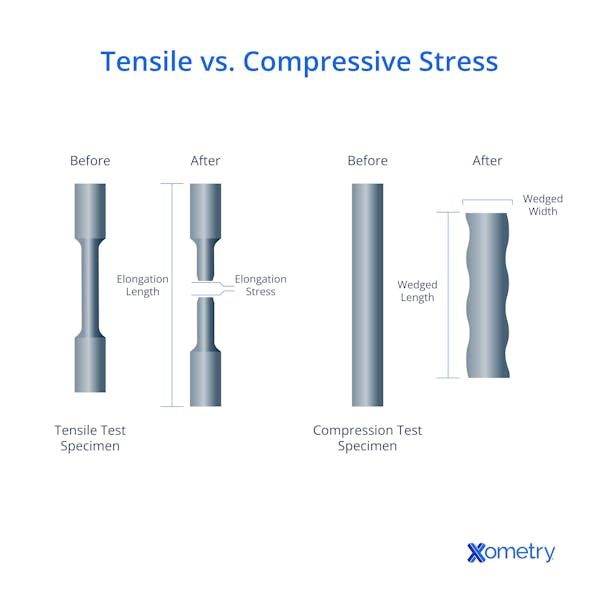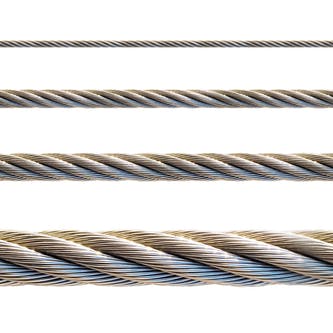If you’ve studied engineering and/or materials science, or work in any related sectors, you’ll likely know all about longitudinal stress — but this isn’t a tidbit that’s typically in the average person’s general knowledge arsenal. It is, however, something you should know about if you’re in the process of finding the right material for your manufacturing needs. This article will explain what it is, how it works, and how to calculate it in any material.
What is Longitudinal Stress?
Also known as axial stress, longitudinal stress is the internal stress that materials suffer when force is applied along their length (the longitudinal axis) causing an increase or decrease in the length and sometimes changing the diameter depending on how elastic the material is. So why is knowing a material's longitudinal stress important? Well, it helps predict its behavior, such as whether and when it will deform or change in its intended application — particularly necessary for buildings, bridges, and machinery that are safe and durable. It’s also a good way for manufacturers to meet strict safety and performance standards. There are two types of stress, tensile and compressive, shown in the below image.

As you can see, these act in opposite directions. Tensile stress (pulling) stretches or pulls along the material’s length, increasing both its length and internal tension. Compressive stress (pushing) happens when a material’s length is squashed, reducing its length and internal compression.
Are Longitudinal Stress and Shear Stress the Same?
No. Longitudinal stress and shear stress represent two distinct forms of mechanical stress that can act on materials. Longitudinal stress occurs when forces or loads are applied in the direction of the object’s length — i.e., along its longitudinal axis. This type of stress leads to either stretching (tensile stress) or compression (compressive stress) of the material along its length. In contrast, shear stress arises when two parallel but offset forces are applied parallel to a given cross-sectional area of material. Shear stress results in a deformation where the material's layers slide or shear past each other. You can, for example, apply longitudinal stress on a sheet of paper by pulling its two ends apart. Scissors, on the other hand, impart shear stress on the paper.
Is Young's Modulus Longitudinal Stress?
No, Young’s modulus, sometimes referred to as the modulus of elasticity, is not the same as longitudinal stress. Instead, Young’s modulus is the longitudinal stress divided by the longitudinal strain.
What Is the Importance of Longitudinal Stress?
Understanding longitudinal stress is crucial for structural analysis, material selection, and ensuring the safety and durability of various engineering components and structures. Engineers rely on a thorough understanding of longitudinal stress to design structures that can withstand external forces without failure. This ensures the safety of buildings, bridges, machinery, and other critical infrastructure. Material selection hinges on the material's ability to handle tensile and compressive stresses along the item’s length. This consideration ensures that the part can bear its anticipated loads without deforming excessively or compromising safety. Additionally, longitudinal stress analysis plays a key role in predicting material durability and service life. It helps prevent premature fatigue and degradation. Aerospace and automotive manufacturers also employ longitudinal stress testing as part of their quality control measures.
How Does Longitudinal Stress Work?
Longitudinal stress describes how a material responds to forces along its length. Imagine a cylinder with equal and opposite forces applied to its ends. This stress is known as longitudinal stress. Calculate it using the formula:
Longitudinal Stress (σ) = Deforming Force (F) / Area of Cross-section (A)
Longitudinal stress occurs when the deforming force acts parallel to the object’s length and both opposing force vectors run through the same axis. It leads to a change in the body's length, and depending on the material's characteristics, it may also cause a change in diameter. Longitudinal stress can be further classified into two main types based on the direction of the deforming force: tensile stress, which elongates the material, and compressive stress, which compresses it.
How Does Longitudinal Stress Differ From Other Types of Stress?
Longitudinal stress differs from other types of stress based on the direction of applied forces and their effects on materials. Longitudinal stress is a type of normal stress that specifically relates to forces that act in an axial direction. Such forces are commonly observed in rods or bars under tension or compression. This type of stress results in either elongation or shortening of the material.
In contrast, shear stress arises when opposing forces act parallel to each other but in opposite directions. The parallel forces act on axes that are offset from one another. It causes a shearing or sliding deformation within the material. Pure shear stress alters the shape without changing the volume and is distinct from longitudinal stress due to its direction and mode of deformation.
There are other types of stress as well. Bending stress arises from bending moments and results in a gradient of both tensile and compressive stresses spread across the material's cross-section. Torsional stress occurs because of twisting or rotational forces, leading to shear stresses within the material that act in radial directions. Volumetric stress affects objects in all three dimensions, changing their volume. Additionally, fatigue stress is a phenomenon associated with cycles of loading and unloading, leading to material failure over time.
What Causes Longitudinal Stress?
Longitudinal stress is induced when two cross-sectional areas of a cylinder or other body experience equal and opposite forces. The applied force operates in the direction of the body's length, potentially causing a change in that length. Longitudinal stress, therefore, leads to either stretching (tensile stress) or compression (compressive stress) of the material along its length.
How Does Longitudinal Stress Differ From Normal Stress?
Normal stress occurs when forces are applied perpendicular to the cross-sectional area of the body. These forces can either lead to tensile stress, causing the material to elongate, or compressive stress, causing it to shorten. The type depends on whether the forces are pulling or pushing against the material's surface. Normal stress can be subdivided into two categories: longitudinal stress and bulk stress (or volumetric stress).
Longitudinal stress is a type of stress that aligns with the length of an item such as a bar. When the cross-sectional area is perpendicular to the bar's length, the normal stress acting on that section is also considered longitudinal. Volumetric stress, by contrast, acts in all directions on the body at once. It can alter the body’s volume as a result. Unlike normal stress, which primarily affects the length of a material, and tangential stress, which alters the shape of the body, volume stress specifically focuses on changes in the body's overall volume.
What Is the Formula for Longitudinal Stress?
There’s a simple formula to calculate longitudinal stress, as follows:
σ = F / A
Where:
σ = longitudinal stress (Pa or N/m²)
F = force applied along the length of the material (N)
A = cross-sectional area of the material perpendicular to the applied force (m²)
You begin by measuring the cross-sectional area of the material perpendicular to its length before any load is applied to it—if this is circular, you’d measure its radius and use that to find the area in square meters, but you could also measure it directly. Next, you have to work out the force that’s being applied along the material’s length, which will typically be in newtons. Once you have both the area and the force, divide the applied force by the cross-sectional area. The last step is interpreting the stress based on the direction of the force — as a reminder, it’s tensile if the force pulls and stretches the material, and compressive if it pushes and compresses.
How to Calculate Longitudinal Stress?
The longitudinal stress is calculated using the formula above. First, you must measure the perpendicular cross-sectional area prior to loading. Next, assess the applied force. Insert those values into the simple formula to calculate the stress. Make sure to use consistent units (e.g., newtons and square meters). Longitudinal stress can be either tensile (positive) or compressive (negative) depending on whether the material is being stretched or compressed along its length.
What Is An Example of Longitudinal Stress?
An example of longitudinal stress is the stretching of a steel cable when it is tensioned. When you apply a pulling force to a steel cable, the internal longitudinal stresses within the cable act in the same direction as its length. The cable will tend to elongate or stretch along its length in response to the applied force.
Another example is the compression of buildings’ steel support columns. In this case, the forces act in a compressive manner along the length of the column, causing it to shorten or contract. This represents another instance of longitudinal stress, this time in compressive form.
Frequently Asked Questions About Longitudinal Stress
How Does Longitudinal Stress Affect the Quality of Materials?
If the stress that a material is put under is more than what it can handle (more than its yield strength), it’s likely that you’ll get permanent deformation, i.e., cracks or fractures that greatly reduce the quality, reliability, and service life. At the very least, it will increase the need for more frequent maintenance or replacement. So, in answer, it directly impacts the material’s structural integrity and dimensional stability.
How Often Does Longitudinal Stress Occur in Steel?
Yes, steel frequently experiences longitudinal stress. It’s a material used widely in engineering and structural applications, mechanical components, and machinery, so many steel parts are subjected to stretching and compressive forces. In construction, designing steel-framed structures, including buildings and bridges, requires careful analysis of longitudinal stress to know how the material will react under various loading conditions.
Does Longitudinal Stress Occur in Titanium?
Titanium is also affected by this type of stress, and the severity will depend on the specific application and the type of forces involved. For instance, titanium components in space and aircraft will get it from gravity and aerodynamic loads, which only increase during high-speed maneuvers, turbulence, and hard landings. In medicine, titanium implants used in bone and joint replacement regularly experience longitudinal stresses as they bear weight and accommodate movement. Understanding these stresses is crucial to optimizing the design and performance of titanium components in such demanding applications.
How Xometry Can Help
For additional information about longitudinal stress and its applications, contact an Xometry representative. We also provide a wide range of manufacturing capabilities and other value-added services for all of your prototyping and production needs. Visit our website to learn more or to request a free, no-obligation quote.
Disclaimer
The content appearing on this webpage is for informational purposes only. Xometry makes no representation or warranty of any kind, be it expressed or implied, as to the accuracy, completeness, or validity of the information. Any performance parameters, geometric tolerances, specific design features, quality and types of materials, or processes should not be inferred to represent what will be delivered by third-party suppliers or manufacturers through Xometry’s network. Buyers seeking quotes for parts are responsible for defining the specific requirements for those parts. Please refer to our terms and conditions for more information.


